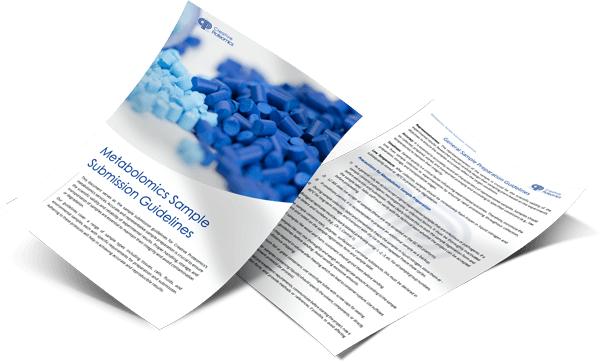Carnitine and Acylcarnitine Analysis Service – Quantitative LC–MS/MS for Research
Comprehensive Profiling for Mitochondrial and Energy Metabolism Research
Creative Proteomics provides advanced carnitine and acylcarnitines analysis services based on quantitative LC–MS/MS technology.
Our platform enables high-sensitivity detection of short-, medium-, and long-chain acylcarnitines (C0–C18) and free L-carnitine from plasma, serum, tissue, and cell samples.
Designed for academic researchers, biotech teams, CROs, and pharmaceutical R&D, this service supports studies on fatty acid oxidation, amino acid degradation, and mitochondrial energy regulation.
Each dataset is delivered with precise quantification, internal-standard normalization, and expert interpretation.
Our Key Advantages
- Quantitative acylcarnitine profile by LC–MS/MS covering both carnitine and its acyl derivatives
- Reliable results across plasma, serum, tissue, and cell samples
- Accurate, validated detection of over 30 carnitine and acylcarnitine species
- End-to-end support from experimental setup to bioinformatics interpretation
Submit Your Request Now
×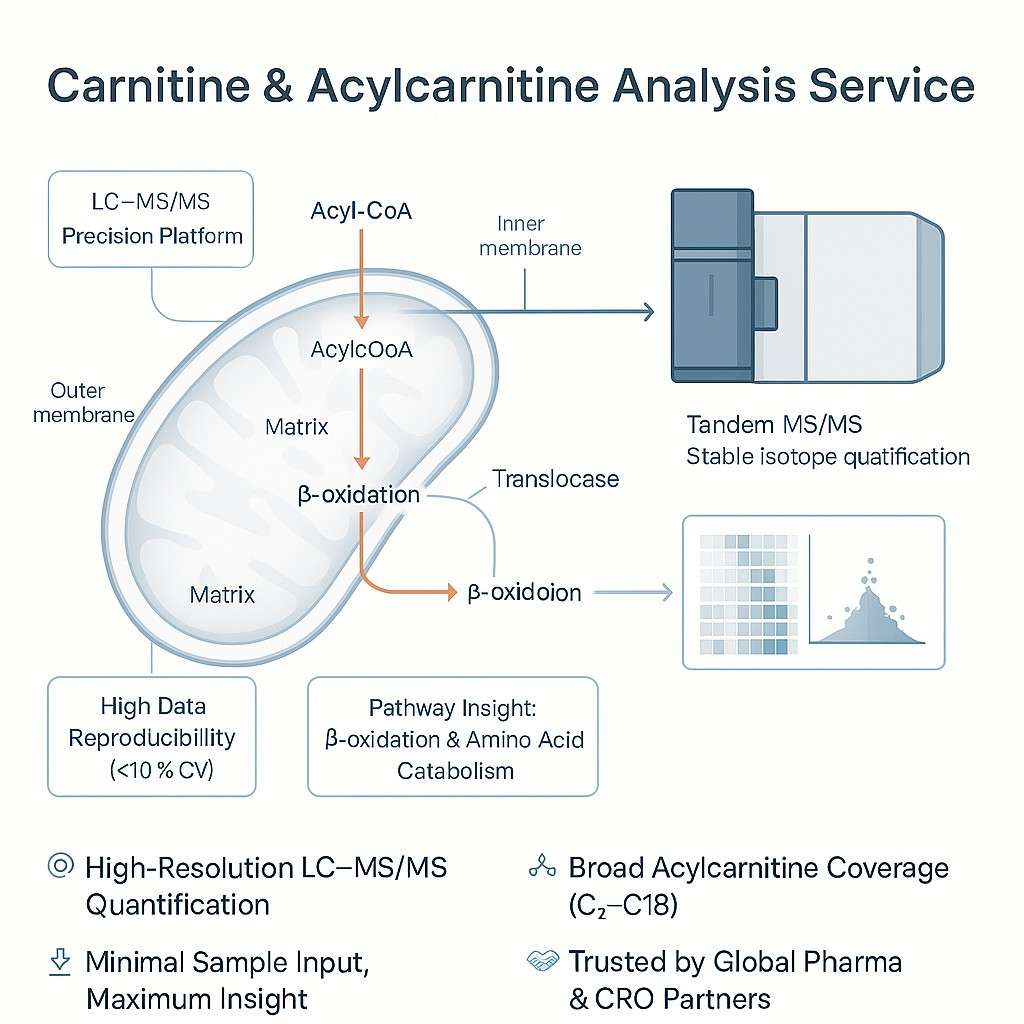
- Advantages
- Metabolites Quantified
- Workflow
- Why Choose Us
- Customer Case
- FAQ
What Are Carnitine and Acylcarnitines – And Why They Matter
What is L-Carnitine?
L-Carnitine is a naturally occurring amino acid derivative found in all mammalian species.
Its primary role is to transport activated long-chain fatty acids into the mitochondria, enabling β-oxidation and cellular energy production.
To better understand this process, you can refer to our scientific resource Carnitine Metabolism and Its Role in Fatty Acid Oxidation, which explains how carnitine maintains cellular energy balance.
What Are Acylcarnitines?
Acylcarnitines form when the acyl group from a fatty acyl-CoA is transferred to carnitine via the enzyme system (CPT-I, carnitine-acylcarnitine translocase, CPT-II).
These molecules carry fatty acid chains (C2 to C18 or longer) across mitochondrial membranes and reflect the functional status of fatty acid oxidation.
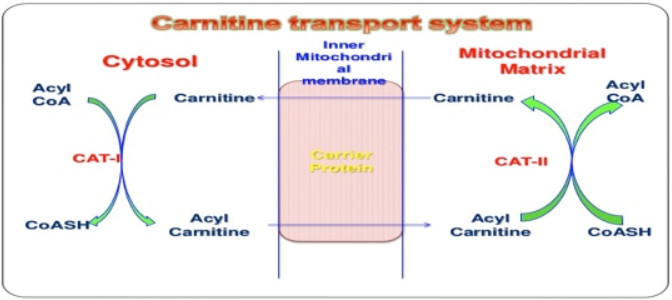
Why Analyse the Carnitine & Acylcarnitine Pool?
- The ratio and concentrations of L-carnitine and its acyl derivatives serve as biomarkers for mitochondrial metabolism, fatty acid oxidation defects, and metabolic stress.
- Disruptions in the carnitine/acylcarnitine system are linked to fatty acid oxidation disorders (FAODs), organic acidemias, and broader metabolic dysfunctions.
- Understanding "what is acylcarnitine" and "what does acylcarnitine profile test for" enables researchers to probe energy metabolism, amino acid catabolism, and mitochondrial transport mechanisms.
Key Take-aways for Researchers
- L-Carnitine and acylcarnitines together form the "carnitine pool" essential for fatty acid and amino acid metabolism.
- Quantitative profiling of this pool (especially via LC–MS/MS) provides a window into mitochondrial health and lipid metabolism.
- Research teams, CROs and pharma developers can use this data for biomarker discovery, drug mechanism exploration, and metabolic phenotype characterisation.
For an in-depth review on acylcarnitine functions and analysis methods, see our resource: Acylcarnitine Functions and Analysis Methods.
Advantages of Our Targeted Carnitine & Acylcarnitine Quantitative Profile
Our precision-driven platform for carnitine and acylcarnitines analysis uses state-of-the-art quantitative LC–MS/MS technology to deliver high-quality data for research in lipid metabolism, mitochondrial biology and drug development.
Researchers looking to integrate this assay with broader metabolomics workflows can explore our Targeted Metabolomics Service, which uses similar quantitative standards and normalization strategies.
Broad Analytical Coverage
- Measures free L-carnitine and a wide range of acylcarnitines—from C2 (acetylcarnitine) through long-chain species like C16 (palmitoylcarnitine) and C18 (stearoylcarnitine).
- One streamlined workflow supplies a comprehensive acylcarnitine profile quantitative MS/MS dataset, reducing the need for multiple separate assays.
High Sensitivity, Accuracy & Reproducibility
- Dedicated LC–MS/MS methods achieve low-picomolar detection limits and excellent quantitative accuracy.
- Validated CVs are consistently under 10% in high-throughput studies—ensuring reliable longitudinal or cohort comparisons.
Isomer and Matrix Resolution
- Chromatographic separation (e.g., HILIC or reversed-phase LC) minimises co-elution of isomeric acylcarnitines and enhances assay specificity.
- Stable isotope-dilution internal standards correct for matrix effects across plasma, serum, tissue, cellular extracts and microbial cultures.
Multi-Matrix & High-Throughput Capability
- Suitable for human, rodent, plant or microbial sample types—thus supporting translational studies and cross-species research.
- Efficient processing enables large sample batches, facilitating CRO-scale metabolomics or biomarker screening projects.
Research-Ready Output for Biomarker & Mechanism Studies
- Data feed directly into metabolic pathway interpretation: fatty acid oxidation, branched-chain amino acid catabolism, mitochondrial dysfunction.
- Ideal for pharmacometabolomic profiling, nutritional intervention studies and energy-metabolism research.
Carnitine Analysis Options (LC–MS/MS and HPLC)
- In addition to LC–MS/MS, Creative Proteomics also provides L-carnitine analysis by HPLC for research that requires UV or fluorescence-based quantification.
- Both acetyl-L-carnitine and acetyl-L-carnitine HCl can be measured precisely for studies investigating carnitine supplementation, energy metabolism, or fatty acid oxidation.
Integrated Lipidomics Platform Supporting Carnitine & Acylcarnitines Quantification
At Creative Proteomics, we provide a comprehensive lipidomics platform that supports our targeted carnitine and acylcarnitines analysis and enhances your overall metabolic research strategy. Our services span from broad discovery workflows to focused quantitative studies in lipid metabolism.
Platform Highlights
- Full-service lipidomics: untargeted profiling, targeted assays and metabolic flux analysis.
- Advanced instrumentation: LC–MS/MS, GC–MS, MALDI-IMS, and shotgun lipidomics across diverse samples.
- Broad sample compatibility: cells, tissues, plasma, exosomes, plants, microbes.
Why This Matters for Your Carnitine & Acylcarnitines Study
- The same robust lipidomics infrastructure underpins our acylcarnitine profile quantitative MS/MS and carnitine analyses, ensuring high accuracy and reproducibility.
- Integration-ready workflows enable seamless linkage of acylcarnitine data with other lipid classes—supporting systems-level insight into fatty acid oxidation, mitochondrial transport, and amino acid catabolism.
- This multi-omics readiness supports translational research, biomarker validation, and pharmacometabolomic studies across pharmaceuticals and biotechnology.
Research-Use Only Compliance
Please note: All our lipidomics, carnitine and acylcarnitine profiling services are for research use only (RUO) and are not intended for clinical or diagnostic decision-making.
Carnitine & Acylcarnitines Quantified in Our Service
Our targeted platform delivers absolute quantification of both free L-carnitine and a wide range of acylcarnitines, enabling deep insight into fatty acid oxidation, amino-acid catabolism and mitochondrial transport mechanisms. The table below presents representative analytes included in our carnitine and acylcarnitine profile quantitative MS/MS service.
| Chain Length / Modification | Analyte Example | Notes |
|---|---|---|
| Free Carnitine (C0) | L-carnitine | Baseline pool carrier molecule |
| Short-chain (C2–C5) | Acetyl-(C2), Propionyl-(C3), Butyryl-(C4) | Reflects acetyl/propionyl metabolism |
| Medium-chain (C6–C10) | Hexanoyl-(C6), Octanoyl-(C8), Decanoyl-(C10) | Key for medium-chain fatty acid oxidation |
| Long-chain (C14–C18) | Myristoyl-(C14), Palmitoyl-(C16), Stearoyl-(C18) | Reflects transport of long-chain fatty acids |
| Unsaturated/modified chains | Oleoyl-(C18:1), Linoleyl-(C18:2), 3-OH-Palmitoyl-(C16-OH) | Adds detail on unsaturation and hydroxylation |
| Dicarboxylic/hydroxy derivatives | Glutaryl-(C5-DC), 3-OH-Dodecanoyl-(C12-OH) | Indicates branched-chain amino acid catabolism & mitochondrial stress |
This broad coverage ensures robust profiling of the "carnitine and acylcarnitines" pool, supporting high-fidelity acylcarnitine quantitative profile plasma and tissue analyses for research and drug-development applications.
Service Workflow
Sample Submission & QC Check – Clients submit plasma, serum, tissue, cells, or biofluid samples.
Extraction & Derivatisation – Biological matrix is processed to extract free L-carnitine and acylcarnitines and remove interfering components.
LC–MS/MS Detection – Quantification occurs using targeted tandem mass spectrometry (MS/MS) with multiple reaction monitoring and stable isotope internal standards.
Data Processing & Normalisation – Analytical signals are converted to concentration units (µM/mL) with quality control metrics (CV<10%).
Reporting & Interpretation – Final report includes quantitative tables, charts, and expert commentary on acylcarnitine profile and carnitine status.
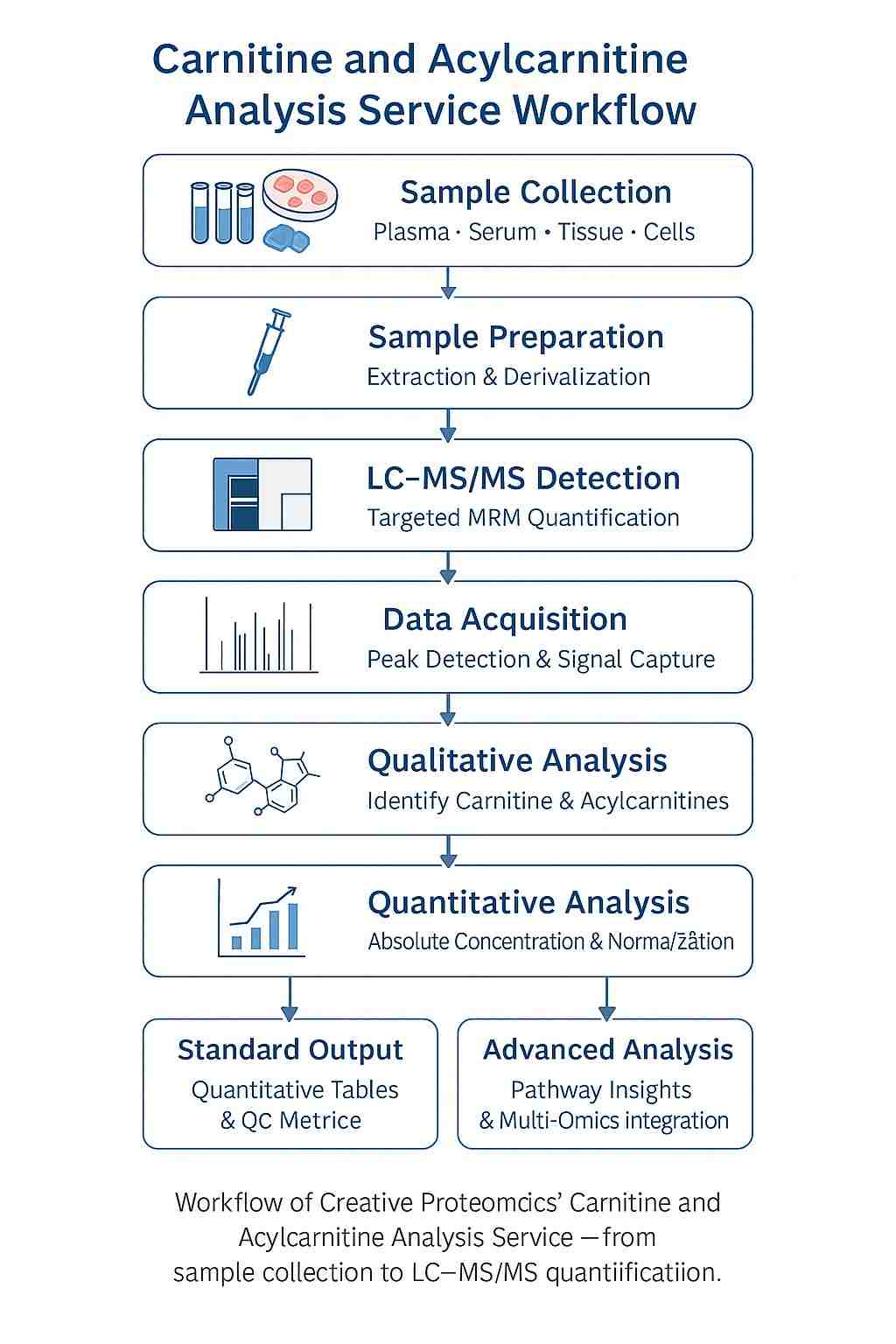
Deliverables & Data Output
Creative Proteomics provides clear, structured results to help you interpret the carnitine and acylcarnitines profile with confidence.
Deliverables Include
- Overview of analytical methods and LC–MS/MS parameters used
- Quantitative results for L-carnitine and multiple acylcarnitines (C0–C18)
- Summary table of detected analytes with concentration values and QC information
- Brief interpretation outlining overall trends in carnitine and acylcarnitine levels
- Electronic report (PDF or Excel) suitable for research documentation
Why It Matters
- Provides accurate, traceable data for studies on fatty acid oxidation, amino acid metabolism, and mitochondrial function
- Enables direct comparison between experimental groups in targeted metabolomics research
- Ensures transparent reporting in compliance with research-use-only standards
Note: This service and its results are for research use only (RUO) and not intended for clinical diagnosis or patient care.
Why Partner with Creative Proteomics
Choosing Creative Proteomics means working with a trusted research partner experienced in metabolomics, lipidomics, and integrated multi-omics analysis.
Our carnitine and acylcarnitine analysis service is supported by the same robust infrastructure used in our proteomics, transcriptomics, and genomics workflows—enabling you to extend insights beyond single-pathway measurements.
Why Researchers Choose Us
- Comprehensive multi-omics integration – combine carnitine and acylcarnitine profiling with proteomics, transcriptomics, or lipidomics for deeper biological context.
- Consistent analytical quality – unified LC–MS/MS and bioinformatics standards ensure cross-platform comparability.
- Tailored scientific support – our technical team assists with study design, data interpretation, and method selection.
- Secure and transparent process – all projects follow strict quality control and confidentiality protocols.
- Global collaboration readiness – trusted by research institutions, CROs, and biotechnology clients for data-driven discovery.
Creative Proteomics provides the tools, expertise, and flexibility you need to transform carnitine and acylcarnitine data into meaningful biological insight.
Applications & Research Use Cases
The carnitine and acylcarnitine analysis service from Creative Proteomics provides actionable data for diverse research areas across basic, translational, and applied sciences.
1. Metabolic and Mitochondrial Research
- Assess β-oxidation efficiency and mitochondrial energy regulation.
- Identify metabolic imbalances in fatty acid or amino acid catabolism.
- Explore mitochondrial stress responses in cell and animal models.
2. Pharmacometabolomics and Drug Development
- Evaluate drug-induced effects on mitochondrial metabolism.
- Support preclinical screening and target validation through quantitative metabolic fingerprints.
- Investigate energy-related toxicity or metabolic rescue mechanisms.
3. Nutritional and Clinical Research (RUO)
- Examine the impact of diet, exercise, or supplements such as L-carnitine and acetyl-L-carnitine (ALCAR) on energy metabolism.
- Correlate nutrient intake with plasma acylcarnitine profiles for metabolic health assessment.
4. Multi-Omics Integration
- Combine carnitine and acylcarnitine profiling with lipidomics, proteomics, or transcriptomics to reveal regulatory links between metabolism and gene expression.
- Generate systems-level insights into disease pathways, therapeutic mechanisms, or biomarker panels.
These applications highlight how carnitine and acylcarnitines serve as versatile indicators of cellular energy status, offering high-value data for metabolism-related research and biopharmaceutical innovation.
Sample Requirements
| Sample type | Recommended sample size | Pre-treatment and storage |
|---|---|---|
| Tissue | 100-200 mg | Snap freezing in liquid nitrogen, stored at -80℃. |
| Urine | 200-500 μL | 5000×g 4℃ Centrifuge for 30-60min, remove supernatant, store at -80℃. |
| Serum/plasma | >100 μL | Collected serum/plasma, snap freezing in liquid nitrogen, stored at -80℃. |
| Cerebrospinal fluid, amniotic fluid, bile and other body fluids | >200 μL | 4℃ Centrifuge for 10min, (or filter using 0.22μm membrane), remove supernatant and store at -80℃. |
| Suspension cells | >1*107 | Centrifuge and collect cells after liquid nitrogen snap freezing and store at -80℃. |
| Walled cells | >1*107 | Cultured walled cells are stored in 1.5ml centrifuge tubes, snap freezing in liquid nitrogen and stored at -80℃. |
| Cell supernatant | >2 mL | centrifuge at 4℃ for 3 minutes, take the supernatant and store at -80℃. |
Get Started with Your Carnitine and Acylcarnitine Analysis Project
Gain deeper insights into mitochondrial metabolism and fatty acid oxidation with Creative Proteomics' carnitine and acylcarnitine analysis service.
Our technical specialists can help you design the right workflow, select suitable sample types, and interpret your results in the context of your broader research goals.
How to Begin
- Contact our team with your project outline or study objective.
- We'll recommend an appropriate analytical strategy and provide a tailored quotation.
- Once samples are received, our scientists will carry out LC–MS/MS-based quantification and deliver organized data for your research records.
Collaborate with Confidence
Whether you're studying metabolic pathways, evaluating drug effects, or integrating data across proteomics and metabolomics, Creative Proteomics offers the expertise and platform consistency to support your next discovery.
Customer Case Study: Quantification of Ketone Bodies by LC–MS/MS and NMR in Human Plasma
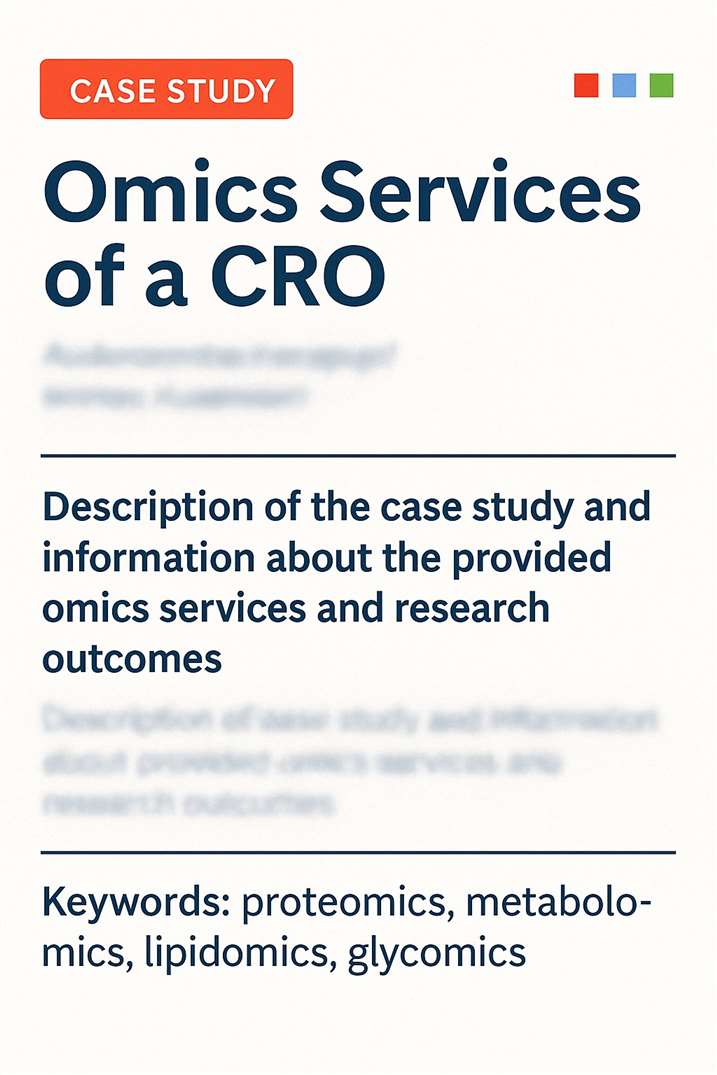
- Background
- Methods
- Results
- Conclusions
Accurate quantification of ketone bodies such as β-hydroxybutyrate (β-HB), acetoacetate (AcAc), and acetone is essential for studying mitochondrial fatty acid oxidation and energy metabolism.
In a peer-reviewed study published in the Journal of Clinical Medicine (Garcia et al., 2020; DOI: 10.3390/jcm9020321), researchers compared LC–MS/MS, GC–MS, and NMR methods for ketone body quantification in plasma samples from individuals with type 2 diabetes mellitus (T2DM).
This study demonstrates how LC–MS/MS platforms—such as those offered by Creative Proteomics—enable accurate metabolite quantification and support metabolic biomarker validation.
Human plasma samples were analyzed using both NMR spectroscopy and LC–MS/MS for β-HB and AcAc quantification, while acetone was measured by GC–MS.
Creative Proteomics performed the LC–MS/MS and GC–MS analyses on a Waters Quattro Premier XE and Shimadzu 2010 GC-MS system, using a multiple reaction monitoring (MRM) approach for quantitative accuracy.
Comparative analyses included Deming regression and Bland–Altman plots to assess method agreement across platforms.
 Figure 1. Deming regression comparison of LC–MS/MS and NMR quantification of β-hydroxybutyrate, acetoacetate, and acetone in serum samples.
Figure 1. Deming regression comparison of LC–MS/MS and NMR quantification of β-hydroxybutyrate, acetoacetate, and acetone in serum samples.
The Creative Proteomics LC–MS/MS data demonstrated excellent agreement with NMR results, confirming the reliability of both techniques for quantifying ketone bodies at physiological and pathological levels.
The correlation coefficients between methods were R2 = 0.996 for β-HB, 0.994 for AcAc, and 0.994 for acetone, validating cross-platform precision.
Moreover, plasma from individuals with T2DM showed mild but significant elevations in ketone bodies, inversely associated with insulin resistance measured by the Lipoprotein Insulin Resistance Index (LP-IR).
This study established the feasibility of LC–MS/MS as a confirmatory platform for NMR-based biomarker discovery.
By leveraging Creative Proteomics' targeted LC–MS/MS analytical platform, the investigators successfully validated an NMR-based clinical assay for β-HB, AcAc, and acetone quantification.
The study demonstrated that ketone body levels can serve as sensitive metabolic indicators for insulin resistance and fatty acid oxidation efficiency in metabolic disease research.
This collaboration highlights Creative Proteomics' capability to provide high-accuracy LC–MS/MS metabolite quantification services that complement NMR and other omics workflows, helping clients establish robust, cross-validated biomarker assays.
FAQ
What is carnitine and acylcarnitine analysis?
Carnitine and acylcarnitine analysis quantifies free L-carnitine (the molecule that transports fatty acids into mitochondria) and its acyl derivatives using LC–MS/MS. These measurements provide a snapshot of mitochondrial fatty-acid oxidation and amino-acid catabolism, helping researchers interpret metabolic pathways and energy regulation.
What can the acylcarnitine profile test for?
An acylcarnitine profile highlights abnormalities in fatty-acid oxidation and branched-chain amino-acid degradation by identifying unusual concentrations of specific acylcarnitines—this is often used in metabolic research to assess mitochondrial function and detect metabolic stress or dysfunction.
Which sample types can be used for the analysis of carnitine and acylcarnitines?
Our service accepts plasma, serum, tissue, cell extracts and other biofluids. The quantification of short-, medium- and long-chain acylcarnitines (C0–C18) alongside L-carnitine enables flexible application across human, animal or cell-based research models.
How does this analysis support drug development and biomarker discovery?
By delivering quantitative data on the “carnitine and acylcarnitine” pool, researchers can monitor how interventions affect fatty-acid transport, mitochondrial energy yield and amino-acid catabolism. Such insights drive pharmacometabolomics, nutritional studies and translational biomarker programmes.
Can this data be integrated with other omics platforms?
Yes. Our carnitine and acylcarnitine profiling is designed to integrate seamlessly with proteomics, transcriptomics and lipidomics datasets—enabling systems-level insights into metabolic regulation, gene expression and pathway interplay.
Is this service suitable for diagnosing clinical disorders?
No. This service is intended strictly for research use only (RUO) and not for clinical diagnostics or patient management. While patterns in acylcarnitines may suggest metabolic dysfunction (such as fatty-acid oxidation disorders), definitive diagnosis requires clinical-grade testing and further confirmatory steps.
Learn about other Q&A about proteomics technology.
References
- Garcia, E.; Shalaurova, I.; Matyus, S.P.; Oskardmay, D.N.; Otvos, J.D.; Dullaart, R.P.F.; Connelly, M.A. Ketone Bodies Are Mildly Elevated in Subjects with Type 2 Diabetes Mellitus and Are Inversely Associated with Insulin Resistance as Measured by the Lipoprotein Insulin Resistance Index. J. Clin. Med. 2020, 9, 321.
- Morand, R., Donzelli, M., Haschke, M. et al. Quantification of plasma carnitine and acylcarnitines by high-performance liquid chromatography-tandem mass spectrometry using online solid-phase extraction. Anal Bioanal Chem 405, 8829–8836 (2013).
- Giesbertz P, Ecker J, Haag A, Spanier B, Daniel H. An LC-MS/MS method to quantify acylcarnitine species including isomeric and odd-numbered forms in plasma and tissues. J Lipid Res. 2015 Oct;56(10):2029-39. doi: 10.1194/jlr.D061721. Epub 2015 Aug 3. PMID: 26239049; PMCID: PMC4583086.
